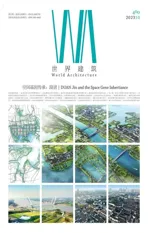塑造城市特色
2023-12-02
总体城市设计是在城市整体层面进行城市风貌特色塑造、文化传承和人性场所营造的主要抓手。然而, 当前的总体城市设计实践中普遍存在一种不顾地方实际、生搬硬套的技术倾向,将模式化、标准化的技术内容架构简单套用于千差万别的城市,难以实现特色塑造的目标,导致设计结果彼此雷同、城市特色缺失。
将空间基因研究纳入常规的总体城市设计流程中,可以提升总体城市设计目标的在地性,并加强该在地性目标的落地性。具体技术路线为:首先,通过空间基因的识别提取,对特色目标进行在地性的判别和校正;其次,通过空间基因的解析评价,提出靶向性的导控策略,实现特色目标的有效传导。目前,该技术方法在恩施、烟台、厦门等全国城市设计试点城市中得到了成功应用。□
Comprehensive urban design is the main tool for enhancing urban identity, inheriting culture and creating humane places at the overall level of the city.However, in the current practice of comprehensive urban design, there is a general tendency to copy and paste the technology without regard to the local reality, and apply the patterned and standardised technical content structure to different cities, which make it difficult to solve the problem of urban identity enhancing and leads to the results of being similar to each other and the lack of urban features.
By incorporating space gene research into the conventional comprehensive urban design process,the localisation of the comprehensive urban design objectives could be enhanced and the realisation of the objectives could be strengthened.The specific technical route is as follows: firstly, through the identification of the space gene, identify and correct the featured target locally; secondly, through the analysis and evaluation of the space gene, propose targeting guiding strategy to realise the effective transmission of the featured target.At present, this technical method has been successfully applied in national urban design pilot cities such as Enshi, Yantai and Xiamen.□
